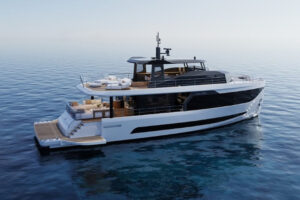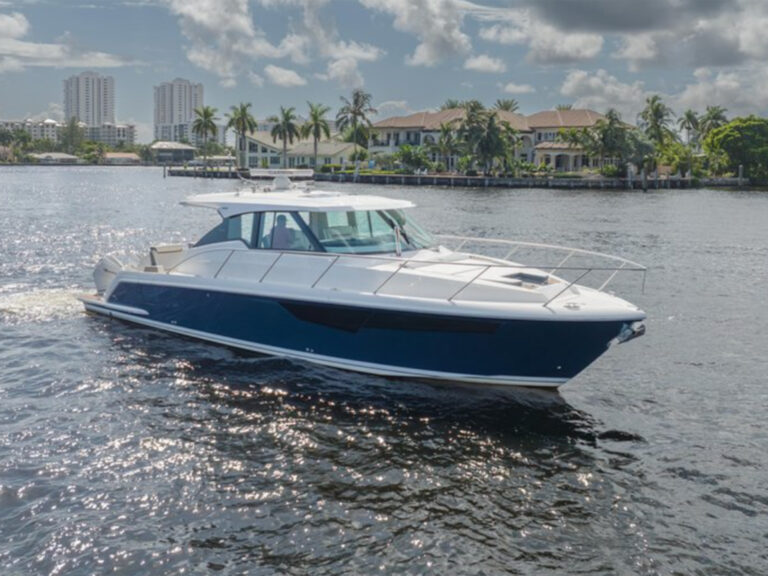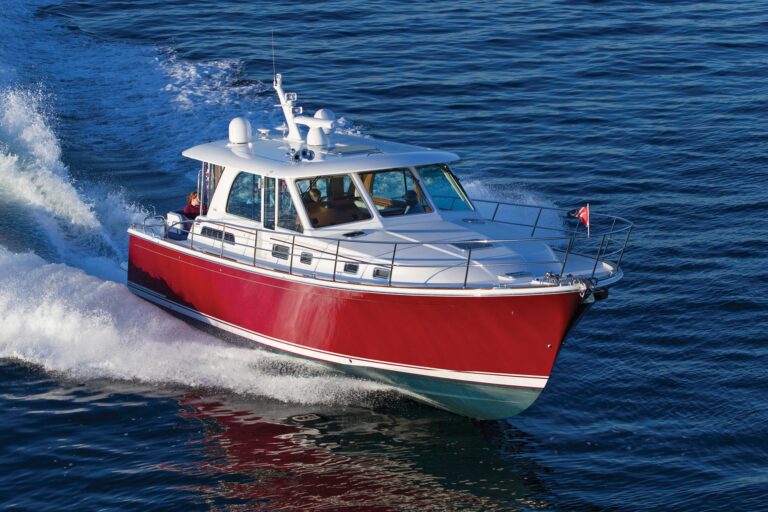Something seemed wrong as we headed out the cut. A sustained northeast wind blew a steady 15 knots, building up 3- to 5-footers off Ft. Lauderdale. The speed calibration on the GPS read a quick-paced 27 knots as the chrome-bedecked 1,480 hp 12V2000 MTUs pushed us smoothly along, but the tachometers barely nudged 1500 rpm. The DDEC displays showed combined fuel consumption at a mere 40 gallons.
I nudged the large single lever controlling the synchronizer to the recommended cruise of 2100 rpm to see whether the curiously efficient numbers would hold. Under 78 percent load, the burn rate did increase to a recognizable 120 gph, but our test boat now clipped wave tops at 39 knots with nearly 300 turns in reserve. Still surprised, I pushed for the big payoff. She hit a top speed of just over 42 knots—a bit shy of the 44 the builder wants, but close enough to call the target realistic after some expected tweaking down the road.
I turned to Thomas Glass, vice president of Roscioli International. My expression was a conspicuous mix of astonishment and elation.
“We don’t build boats for the timid, he said with a smile.
The Donzi R-58 Express Sportfish replaces the 54 as the line’s entry-level offering. The yard, which Bob Roscioli bought in 1988, builds just three to four boats a year from 58 to 80 feet LOA, seeing to everything including installation of the tower and electronics. Custom quality means the turnaround for a new 58 is about 14 months, not an unreasonable length of time for hands-on owners who want to enter the market around $1.75 million or add to their fleet for days when the Trinity or Broward is snug at a mooring. Our test boat, hull number four, was being delivered to the former.
During our test run in the Atlantic, the 58 offered a performance just as noteworthy as her numbers. Her entry was smooth, and the pitch of her huge foredeck was less than I expected. Her wide-beam modified-V hull allowed her to track hard in turns, as I demonstrated while negotiating a beam sea at 34 knots. Glass encouraged me to turn hard to starboard, a task made simple by the hydraulic power steering system. After a few full turns of the wheel, the 58 executed a U-turn perfectly with no cavitation, no loss of power or speed, no slapping and no skidding of the hull. The large, paneled windshield caught the minimal amount of spray, which was generated mostly by wind.
Another distinct feature of her hull is its flawless navy finish. I looked hard for print-through and imperfections, but found none. The mirror-like quality is the result of a baking process in which the hull is cured in a cocoon-like structure and monitored for four or five days at 140 degrees.
The entire design is low profile, and any Donzi Yachts groupie will have little problem identifying the pronounced S-sheer. While the look is dramatic, the styling did cause me some consternation when transiting to the bow. The nonslip surface is not exceptionally aggressive, handholds are at a minimum and it is a tricky tract to follow, especially when wet. The same is true when venturing forward to the anchor locker with no bow rail. Owners who don’t mind detracting from the boat’s sleek look should add a rail.
Construction techniques amount to light weight and exceptional strength, though at 64,000 pounds she is no lightweight. The 58 has a Divinycell-cored hull with solid laminates at all through-hull penetrations. The longitudinal stringers are single-piece structures also made of Divinycell that incorporate a compression member, run the length of the hull and are fully glassed, not tabbed to the main structure. The stringers are notched and fully glassed in place. Engine stringers have steel inserts and aluminum caps.
The running gear and steering are also built to take a beating. The rudderposts are 21/4-inch Aquamet stock with full shaft logs. The rudder shelf is made from high-tensile aluminum. Exhaust exits via a Soundown system. Shafts are held by custom single-leg struts and spin four-blade Nibral props fabricated by Michigan Wheels.
Our test boat’s performance was good even with the four aluminum tanks (two saddle tanks in the engine compartment, one in the cockpit and one below the galley) nearly full. The 12V2000s have twin turbo setups. Pushing the throttles to the firewall produced a smooth, smokeless and even climb, with rapid acceleration when the second turbo kicked in. I did not look to adjust the trim at any time.
Windshield wipers are not standard on the 58, but I didn’t need them. Even in a head sea, spray was knocked down. Shifting to trolling or live bait speeds was comfortable, and we backed down without vibration. The test boat was outfitted with a swim platform that did kick up spray, as would be expected. Skippers and the boat will weather bashing into head seas at 30 knots, but how often is that really necessary? With short 5-footers on the nose, I found the ride a bit hard at a 34-knot cruise. Go figure.
Although this express yacht is 58 feet, the builder resisted the temptation to cram amenities and accommodations into every available space. The result is an open boat with good creature comforts, including room for an Eskimo ice maker, dual freezers and the customary fishing prep and stowage areas in the space separating the cockpit from the deckhouse.
The 120-square-foot cockpit feels a lot bigger than it is. Freeboard is a comfortable 26 inches, suitable for keeping youngsters in place or wiring fish. Tagging will require a mid-length stick, as the reach to the water is 39 inches. Gunwales are very wide; even a double-digit count of rodholders will not overwhelm them. The cockpit also has a wide gutter system, side scuppers, and heavy-duty hatches and hardware leading to the lazarette.
Options include an open or enclosed bridge and a cruising or island helm. I enjoyed the cruising helm, which positions the skipper farther forward and provides a good line of sight ahead. I think this setup will service fishermen, as well, though the island helm is set farther aft for complete cockpit access and visibility. Accommodation layouts change with the different helm configurations, gearing the berths for corresponding cruising or fishing applications.
Fit and finish are what is expected of a custom-quality yard. Joinery is teak, and the cabin sole is teak and holly. There are no uneven seams, exposed wiring or exposed conduits, and all spaces are painted.
The engineroom is well laid out, housing all machinery along with a wide egress and work area. Huge air boxes are on both sides of the compartment, and high-capacity blowers circulate air and cool the area. Batteries are housed in neatly finished boxes with teak tops, lighting is excellent and 110-volt outlets are conveniently placed. Since each cylinder of the 12V2000 MTUs can be individually serviced, engine hatches are not provided, which is fine short of catastrophic failure. The cockpit engineroom door is 2 feet, 2 inches wide and will allow a genset change if need be. Between the engine stringers is 2 feet, 5 inches of room with 5 feet, 8 inches of headroom. The stringers themselves are 19 inches.
Wiring for ship’s electrical service is neatly bundled. Though all panels are well labeled, the 58 lacks the extensive wiring and systems documentation found on some other boats in her class.
The Donzi R-58 Express Sportfish is a well thought out design built with strong attention to detail. It’s easy to see why the builder is known for standing behind its product.
Contact: Roscioli Yachts International, (954) 581-9200; www.donziyachts.com.









